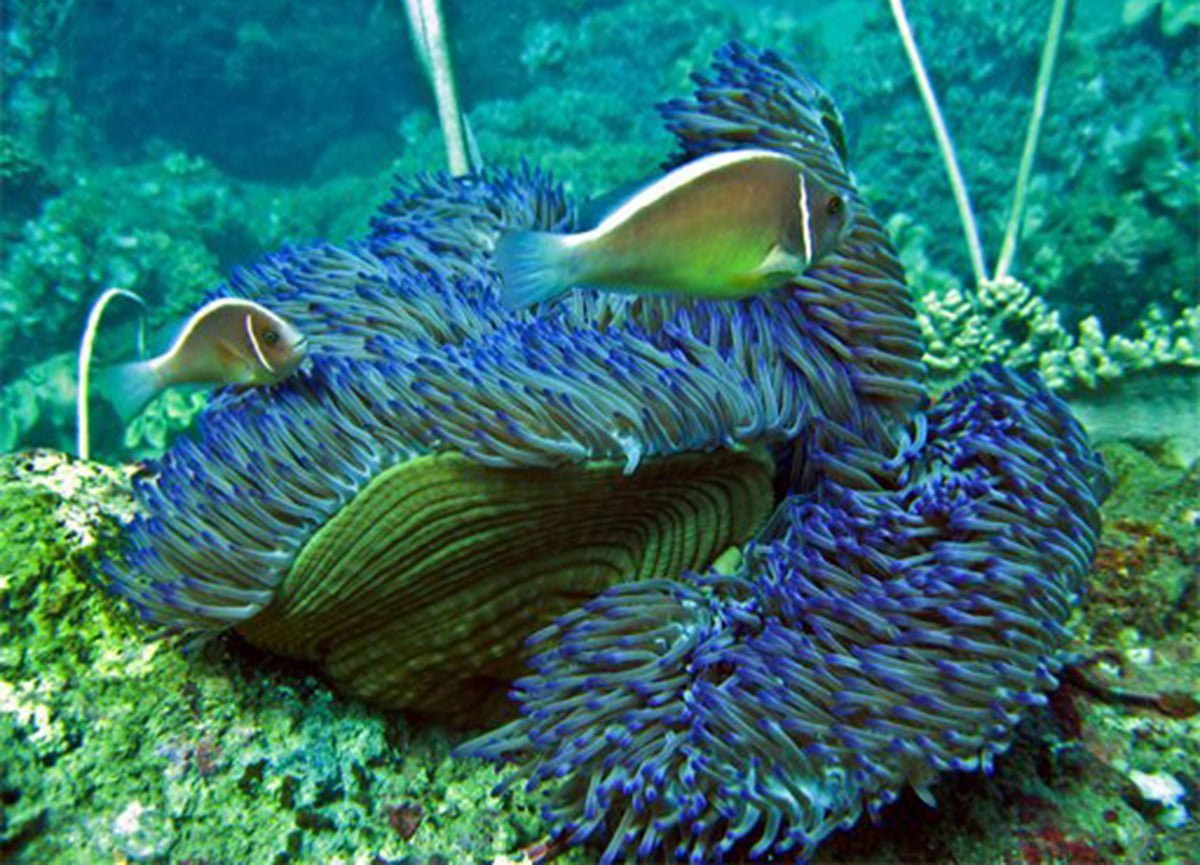This insight comes from Dr. Nguyen Song Tung, Director of the Institute of Human Geography and Sustainable Development under the Vietnam Academy of Social Sciences.
Vietnam ranks among the world’s top 10 marine biodiversity centers

Coral and seagrass create ideal habitats for marine species. Photo: Cu Lao Cham Marine Protected Area.
Citing the International Union for Conservation of Nature (IUCN), Dr. Nguyen Song Tung stated that Vietnam’s seas are home to around 11,000 marine species, found across more than 20 typical ecosystems such as coral reefs, mangroves, seagrass beds, lagoons, and tidal flats. These ecosystems span six marine biodiversity zones from the Gulf of Tonkin to the Spratly Islands, forming a vibrant underwater tapestry.
These ecosystems not only shelter marine life but also act as the ocean’s green lungs, helping regulate the climate, prevent natural disasters, and provide sustainable livelihoods for millions of coastal residents.
"The abundance of marine resources in Vietnam is undeniable. Marine biodiversity conservation should not be viewed as a trade-off with economic development. In fact, it is the foundation of a sustainable blue economy," emphasized Dr. Tung. According to research, coral reef ecosystems can yield up to USD 100 million annually, while seagrass ecosystems contribute USD 20 million, and each hectare of lagoon can generate about USD 2,000 per year through fisheries and tourism services.
Seagrass beds are also powerful carbon sinks, capable of capturing carbon 35 times more efficiently than tropical rainforests. Conserving and restoring seagrass is therefore a key strategy in climate change mitigation.
According to the Vietnam Academy of Science and Technology, Vietnam’s seagrass ecosystems hold an estimated 3.2 million carbon credits, valued at over USD 64 million. This high-value carbon is due to its combined role in biodiversity preservation and climate regulation.
With a coastline stretching over 3,200 kilometers and an exclusive economic zone exceeding 1 million square kilometers, Vietnam is not only a maritime nation but also one of the world’s leading marine biodiversity centers. According to the IUCN, Vietnam ranks among the top 10 in marine biodiversity and is in the top 20 regions globally for abundant fishery resources.
Urgent need to halt ecosystem decline
Dr. Tung noted that in recent years, scientists and policymakers have observed alarming signs. Vietnam’s marine ecosystems are rapidly degrading. The Mekong Delta has lost 80% of its mangrove forests over the past five decades, mostly due to aquaculture expansion and land reclamation. Coral bleaching is widespread, with coral cover in many areas dropping below 20%. Seagrass beds are shrinking due to pollution and overexploitation.
Natural fish stocks are dwindling, and the average size of caught fish is decreasing, indicating that harvesting pressure exceeds the ocean’s regenerative capacity.
Vietnam has actively joined global initiatives to protect the ocean. As a member of the Global Ocean Alliance (GOA), the country has pledged to help conserve at least 30% of the world’s oceans by 2030. It is also a party to the High Seas Treaty and various international conventions on marine biodiversity conservation.
Domestically, the government has launched the National Action Plan on Ocean Plastic Waste Management to 2030, a strategic move to combat marine pollution, one of the leading causes of habitat destruction.
To protect marine ecosystems, Vietnam has developed a national network of MPAs. As of June 2025, 11 out of 16 designated MPAs have been established, including prominent sites such as Cat Ba, Cu Lao Cham, Nha Trang Bay, Con Dao, and Phu Quoc. These areas play a vital role in habitat restoration, maintaining breeding grounds, and supporting sustainable economic activities such as responsible fisheries, ecotourism, and aquaculture.
However, the protected area remains limited compared to the scale and significance of Vietnam’s marine territory. Expanding and improving MPA management is a pressing need.
Marine conservation cannot rely solely on central policies or government agencies. It requires the active participation of coastal communities, businesses, and individuals.
The first step is to change the perception of conservation. It should not be seen as a development barrier but rather as the foundation for sustainable growth. Central Resolution No. 36-NQ/TW (2018) on the Strategy for Sustainable Marine Economic Development clearly emphasizes the shift from mere exploitation to sustainable use and conservation.
To achieve this, Vietnam’s policy and legal frameworks must be revised to better align with current realities, especially in the context of climate change and international integration. Laws such as the Law of the Sea, the Law on Marine Resources and Environment, the Biodiversity Law, and the Environmental Protection Law need to be synchronized, coherent, and practical.
Enhancing the participation of local communities and the private sector is also crucial. Conservation should not be the sole responsibility of the government. Coastal residents, businesses, and civil society all have roles to play. From co-management models in fisheries and community-based coral reef stewardship to responsible ecotourism initiatives, these efforts should be encouraged and supported.
Stricter enforcement against illegal, unreported, and unregulated (IUU) fishing is also needed. Improving vessel monitoring systems and strengthening fishery management capacities will not only help Vietnam lift the EU’s “yellow card” but also secure the future of its fishing industry.
Finally, marine conservation and climate change response must go hand in hand. Marine ecosystems – from coral reefs to seagrass beds – are “green shields” that absorb carbon and mitigate climate impacts. Every action to protect the ocean today contributes directly to Vietnam’s net-zero commitment by 2050.
Everyone can contribute, starting with small actions: reducing single-use plastics, not littering the sea, and following fishing regulations. Tourists can choose eco-friendly tours. Businesses can invest in sustainable fishing and aquaculture. These actions help preserve the invaluable treasure hidden beneath Vietnam’s seas.
nongnghiepmoitruong.vn